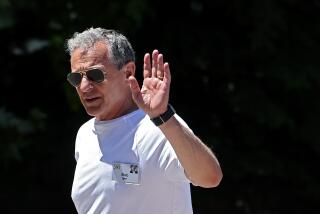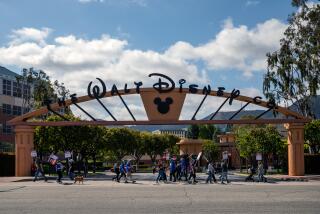What’s Making Top Disney Execs Decide to Go?
Michael Eisner is great at making his top executives rich with Disney stock. But can he make them happy enough to stay at the company?
In recent weeks, the Walt Disney Co. chairman has lost another batch of top corporate and creative executives, again raising questions about succession and depth in the management ranks of one of the world’s largest entertainment conglomerates.
“It doesn’t warm your heart to see a lot of people leave at the same time,” said one senior Wall Street executive close to Disney.
Some wonder whether the company’s corporate culture and the man at the helm--who has a contract making sure he will be there until well into the next decade--aren’t to blame for all the turnover at the top in recent years.
“There’s a plus and a minus to Michael,” a former Disney executive said. “He’s autocratic, and therefore difficult to work for. But he’s brilliant and makes great decisions.”
Sources say that to Eisner and other Disney insiders, the situation is no more than the healthy, natural attrition that occurs in any large corporation. They say Eisner believes that the executive ranks at Disney are deeper than those at ABC and at Paramount Pictures when Eisner worked at those companies in the 1970s and early 1980s.
They believe there is no single reason behind the departures. Some reflect the restlessness of ambitious executives seeking bigger opportunities, or feeling creatively stifled, or, in other cases, corporate burnout. Still other executives left after reaching for jobs within Disney that Eisner felt they weren’t cut out for.
Eisner declined comment, but sources say he believes that some of the more talented defectors may want to return to Disney someday.
One industry analyst said corporations like Disney and General Electric “are fabulous training grounds for management.” In fact, more than half a dozen top executives who have left Disney in recent years are now CEOs of other corporations.
That includes Disney’s last two chief financial officers, both of whom left to run huge hotel companies. Stephen Bollenbach now heads Hilton Hotels, and Richard Nanula started Monday in Connecticut as the chief executive of Starwood Hotels & Resorts Worldwide Inc., the nation’s biggest hotel group.
“Whenever I think about any turnover at the Walt Disney Co., it’s because the company allows it,” says Bollenbach, who resigned as Disney’s CFO about two years ago, after Eisner brought in his then-pal Michael Ovitz to be president--a role Bollenbach himself had coveted.
“Because Disney has such bench strength and backup people, they don’t need to chase people,” said Bollenbach, a highly regarded business executive who played an instrumental role in Eisner’s decision to buy ABC. “They replaced me the same day with a really competent guy, and the stock doubled,” he said, jokingly.
Just two weeks ago, Disney chief strategist Lawrence Murphy left. Murphy and Nanula held two of the three corporate executive positions immediately under Eisner’s (the third is held by Senior Executive Vice President Sandy Litvack).
Sources said that Murphy had wanted to succeed Nanula but that Eisner instead selected a highly regarded younger Disney executive, Thomas Staggs.
Murphy insists he wasn’t passed over. He said Eisner offered him a more senior corporate position overseeing finance, brand management and strategic planning but that “I felt it was a good time to cross the boundary and pursue other opportunities.”
Murphy said that the leaving of his friend Nanula, as well as his forthcoming marriage, helped prompt a decision to make a change in his life. “My decision really was a personal one,” he said.
Last week, Disney cable programming chief Geraldine Laybourne--a respected TV executive credited with building Nickelodeon into a powerhouse--stunned the industry by announcing that she was leaving her job after only two years to start her own production venture. Sources at Disney say Laybourne’s resignation was not considered a big blow since she was in a somewhat poorly defined role, removed from line responsibilities; critics inside the company say her greatest success was in self-promotion.
Her supporters say Laybourne was stifled in the job and found she had far less creative latitude at Disney than she had had at Nickelodeon.
Disney defenders note that the company is hardly made up of “yes” men and women, with such independent executives as film chief Joe Roth and the Miramax co-heads Bob and Harvey Weinstein working there.
Laybourne’s role was more restricted, however, because she oversaw such areas as the Disney Channel and shows appealing to children that relate directly to the priceless Disney “brand”--a mandate treated as something akin to protecting the family jewels.
“When you are dealing with the Disney brand, things that are edgy are probably going to get squashed,” said one executive close to Disney.
The back-to-back resignations by Laybourne, Nanula and Murphy can be added to a long list of senior executives who, for one reason or another, left Disney in recent years: Disney Co. President Michael Ovitz, Disney Studios Chairman Jeffrey Katzenberg, TV chief Rich Frank, CFO Gary Wilson, Euro Disney President Philippe Bourguignon and another Walt Disney TV head, Dean Valentine.
By the most obvious measures, their departures haven’t hurt the company. Disney has continued to see double-digit annual earnings growth, and its stock now trades roughly 50% higher than it was last summer. Disney shares closed at $110.81, down $2.44, on Monday on the New York Stock Exchange.
But the defections do raise concerns about succession at a company where the man at the helm hasn’t been willing to share power with a No. 2.
“He suffers from what a lot of other CEOs suffer from,” says one entertainment analyst. “It’s very hard to share the power, and he has not found another Frank Wells [the former Disney president who died in a helicopter crash in 1994], who was someone content to take an inside position and he didn’t crave the spotlight . . . . Michael wants to be the only star.”
“Sure, he’s a control freak,” said one analyst who considers himself a big Eisner fan. “So is [GE chief] Jack Welch.”
Insiders say that Eisner is willing to empower division heads to run the Disney organization, which employs more than 115,000 people and is involved in dozens of different businesses, but that he is resistant to empowering a president at this time.
There have been hints that Eisner may at some point name a president, but many in the firm believe that he would probably make it clear that the executive is an operations manager, not an heir apparent.
“Until he finds someone he intuitively feels good about, someone who will be selfless and subjugate his own ambition--or he doesn’t want to lose someone and it’s the less of two evils--I don’t think he will feel the need for a president,” said one company source.
Despite the lure of potentially valuable stock options, it’s hard for Disney to compete with the kind of opportunities available elsewhere. Nanula is said to have received an extremely lucrative package. Bollenbach received stock options now valued at nearly $100 million.
Nanula, who was recruited at Starwood by a Harvard Business School classmate, says, “You don’t have to be unhappy” to leave Disney.
“I personally feel I had a great future at Disney,” Nanula said. “But you have a chance to run a public company yourself, in an interesting industry, that is the biggest company in the industry to boot. Add to the equation that I’ll be working with my very best friend in the whole world. It’s hard to compete with this.”
Nanula also believes that it speaks well of Eisner that so many executives get recruited.
He said: “Not everything lasts forever. After all, he didn’t stay at ABC and he didn’t stay at Paramount forever.”
More to Read
Inside the business of entertainment
The Wide Shot brings you news, analysis and insights on everything from streaming wars to production — and what it all means for the future.
You may occasionally receive promotional content from the Los Angeles Times.









